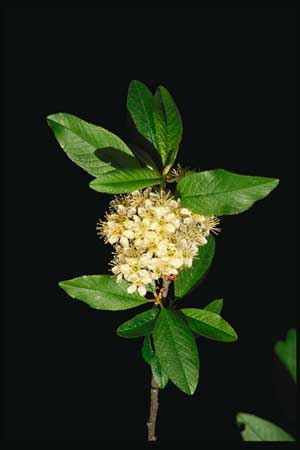
Standard
English Name(s): bitter cherry
Local English Name(s) (if different from above): wild cherry
Scientific Name(s): Prunus emarginata (Dougl.) Walp.
Upriver Halkomelem Name(s): t置lum (bark), t置lumulhp (tree)
Downriver Halkomelem Name(s): t置lum (bark), t置lumulhp
(tree)![]()
Island Halkomelem Name(s): t置lum
(bark), t置lumulhp (tree) ![]()
Description, Habitat,
Ecology, & Distribution:
Bitter cherry is a shrub to small tree,
growing from 2-15 m (6.5-49 ft) tall. The deciduous leaves are finely
toothed and rounded at the tips. The bark is smooth, reddish-brown or
grey, and with prominent horizontal rows of raised pores. The white
or pinkish flowers produce small red cherries. Bitter cherry grows in
moist areas in forests and along streams from low to middle elevations.
Upriver Halkomelem Cultural
Role(s):
The outer bark was peeled and used to
decorate baskets. The inner bark was used as a diarrhea medicine. The
fruits were not eaten, but have been used to thicken jams and jellies.
Downriver Halkomelem
Cultural Role(s):
The bark was used for binding. Teas made
from the bark and dried fruits were used to treat tuberculosis.
Island Halkomelem Cultural
Role(s):
The inner bark of bitter cherry has been
used as an internal medicine for various respiratory ailments and as
an external medicine, as it is considered to be good in the treatment
of infection. The flexible yet strong outer bark has been used as a
wrapping to attach points to fishing spear or harpoon shafts.